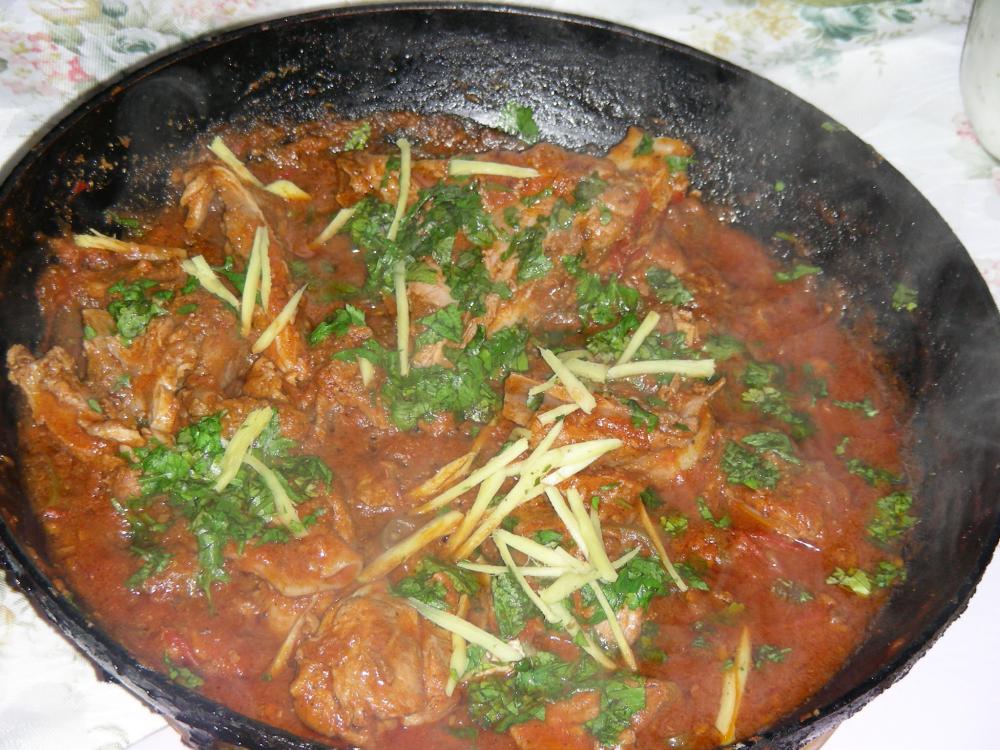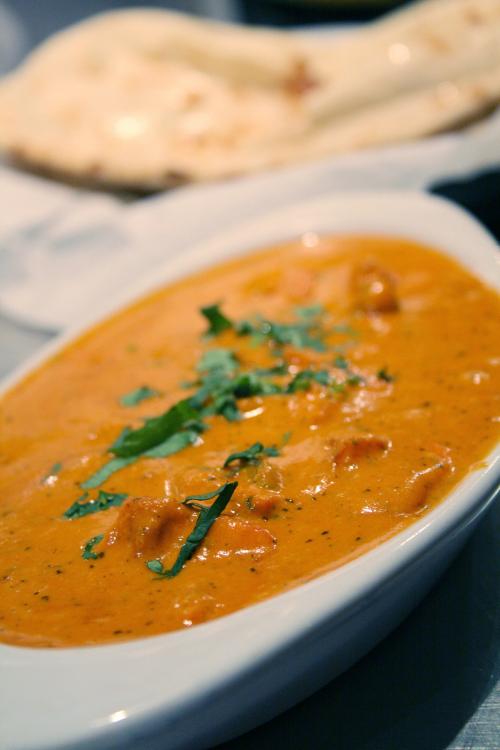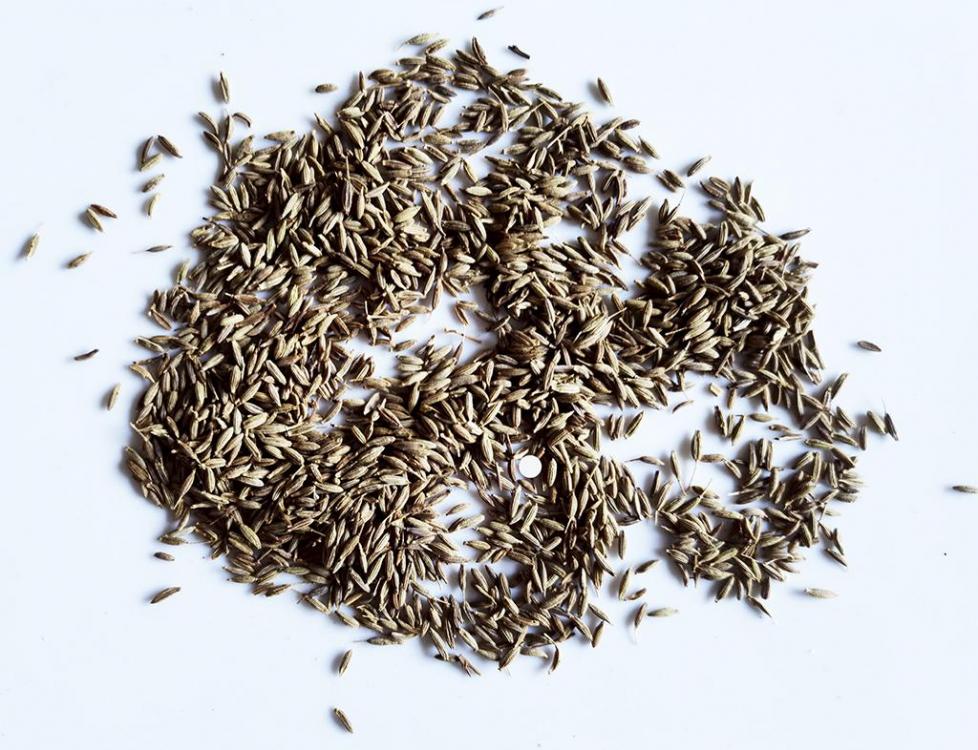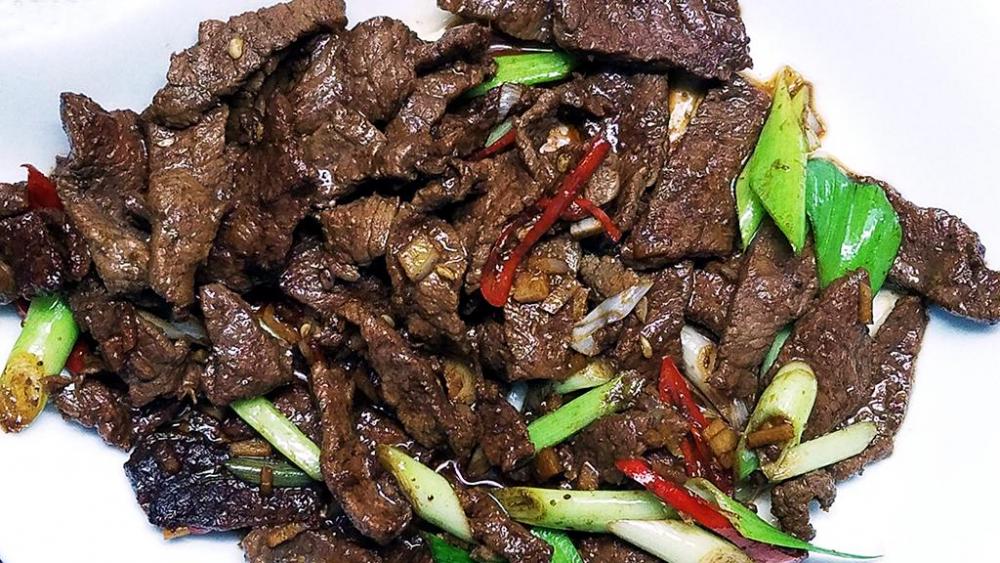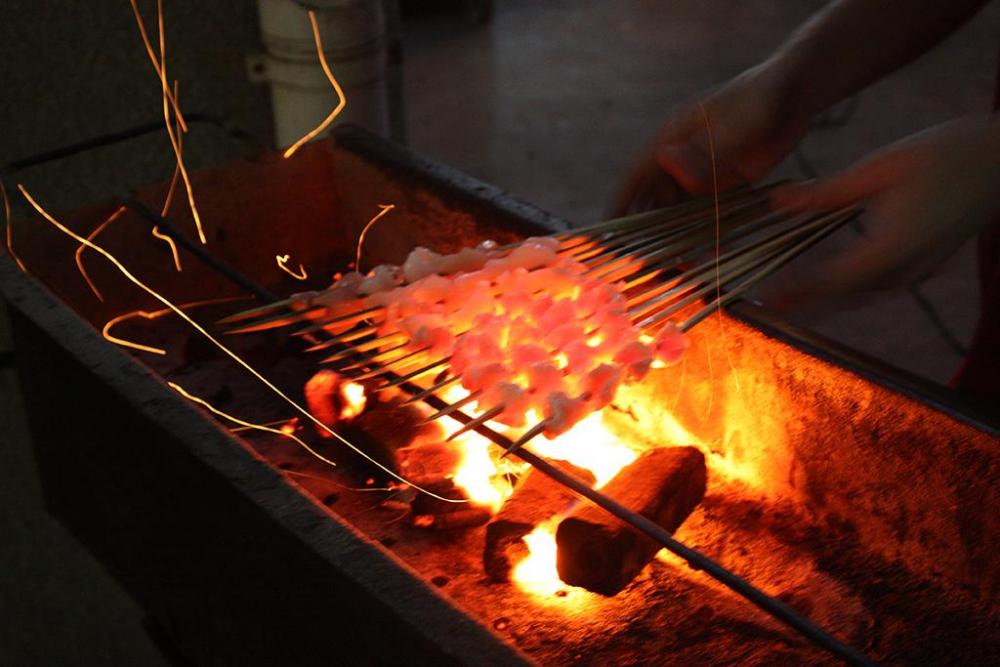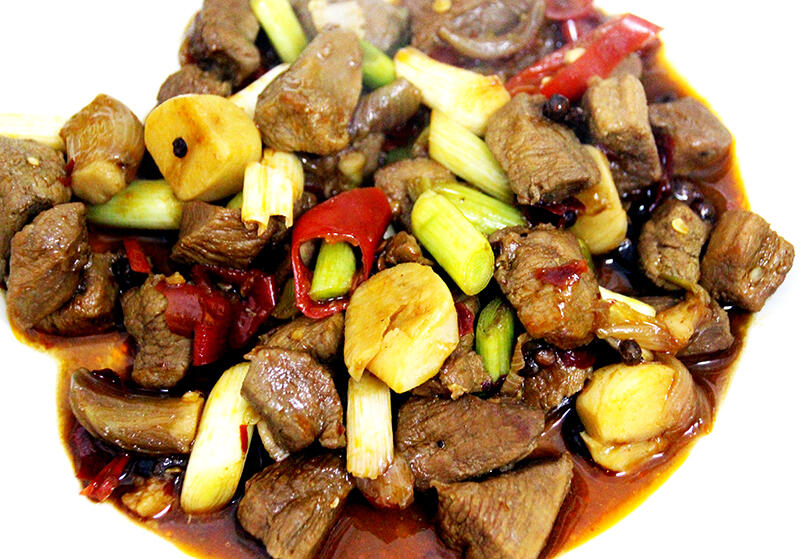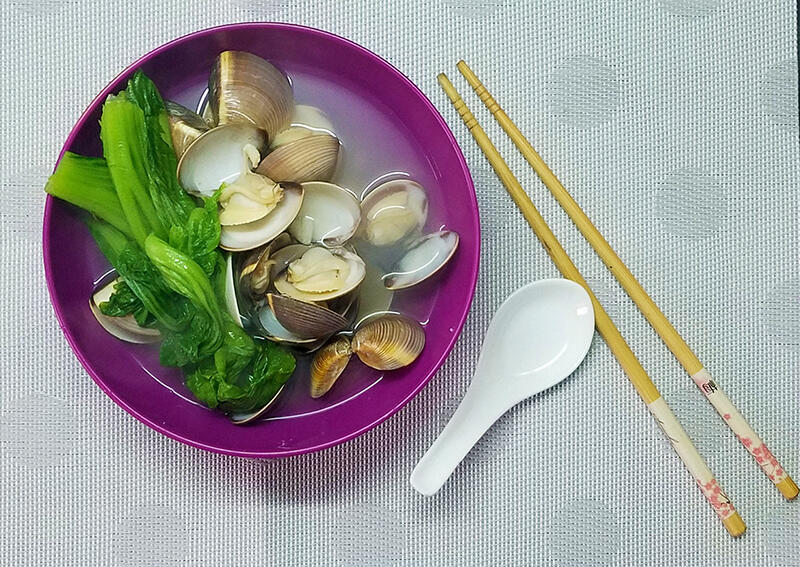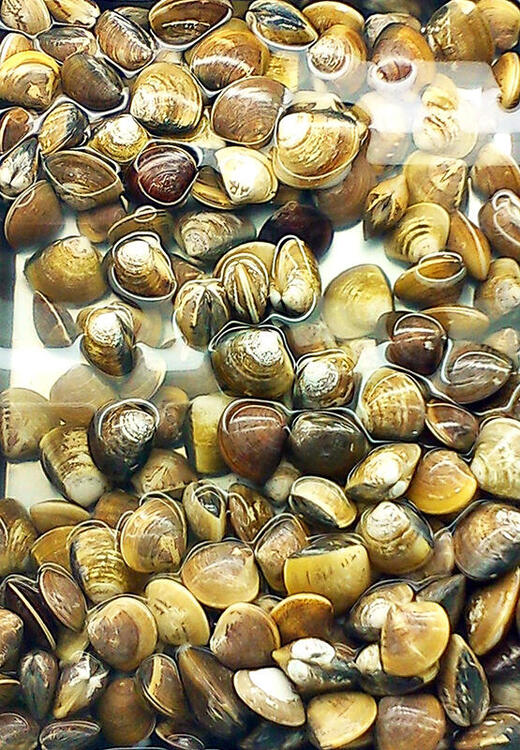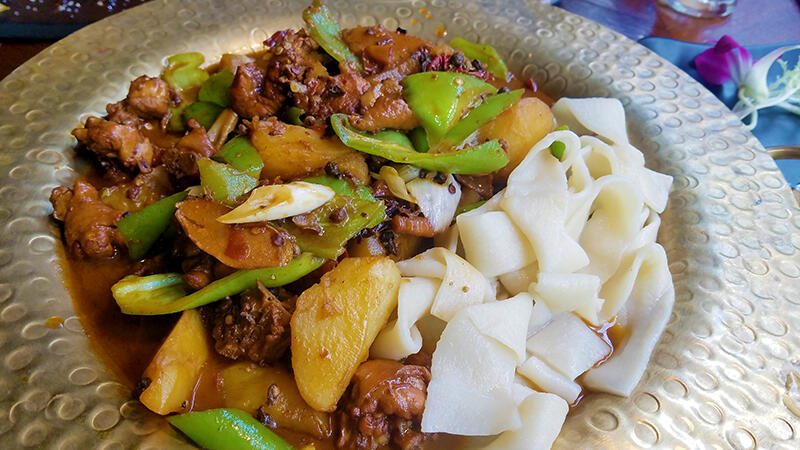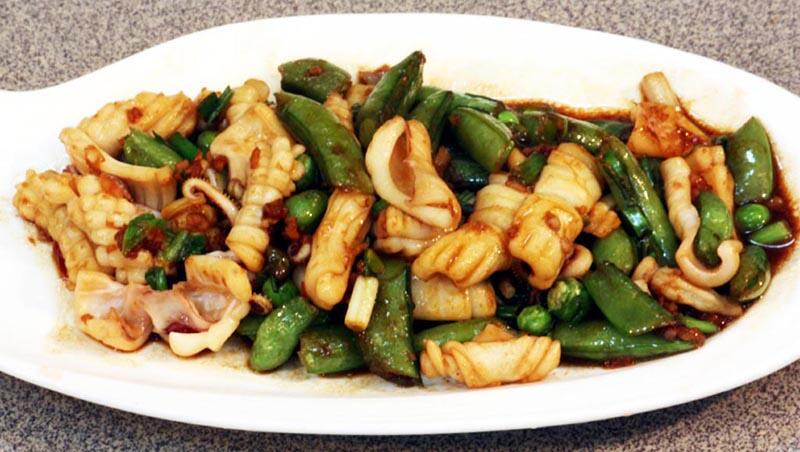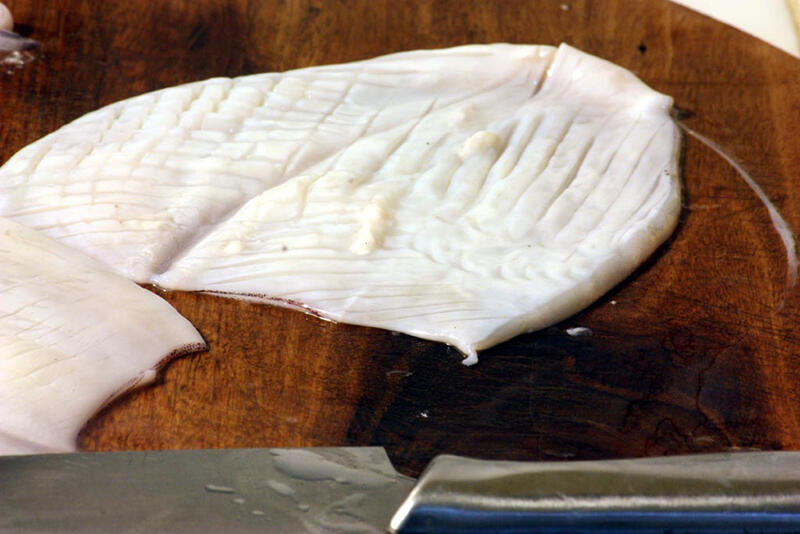Search the Community
Showing results for 'wok'.
Found 5,150 results
-
Hi liuzhou, Do you know this one ? Sichuan(China) Cuisine in Both Chinese and English 中国川菜(中英文标准对照版) ISBN-10: 7536469640 《中国川菜(中英文标准对照版)》重点介绍了180道经典四川菜点的制作方法,全书采用中英文对照的编排方式,是目前国内第一本大型的中英文标准版的地方风味精美图文集。《中国川菜(中英文标准对照版)》的制作团队囊括了国内外饮食文化研究领域的一流专家、川菜烹饪大师、摄影名师等,由此确保了《中国川菜(中英文标准对照版)》内容的权威性。《中国川菜(中英文标准对照版)》文字简洁明了,图片美观精致,翻译标准规范,特别是180道经典四川菜点的制作方法,可供感兴趣的中外读者亲自操作实践,《中国川菜(中英文标准对照版)》具有很高的可读性、观赏性、实用性和指导性。 Content: 封面 扉页 版权页 目录 第一篇 开胃菜 Appetizer 五香牦牛肉 Five-Spice-Flavored Yak Beef 四味鲍鱼 Four-Flavor Abalone 葱酥鱼 Crispy Scallion-Flavored Fish 怪味鸡丝 Multi-Flavored Chicken Slivers 椒麻鸡 Jiaoma-Flavor Chicken 白宰鸡 Baizai Chicken 花椒鸡丁 Sichuan-Pepper-Flavored Chicken 泡椒凤爪 Pickled-Chili-Flavored Chicken Feet 钵钵鸡 Bobo Chicken 腊味拼盘 Cured Meat Platter 卤水拼盘 Assorted Meat Stewed in Sichuan-Style Broth 太白酱肉 Taibai Flour-Paste-Flavored Pork 蒜泥白肉 Pork in Garlic Sauce 酱猪手 Flour-Paste-Flavored Pork Feet 糖醋排骨 Sweet-and-Sour Spareribs 烟熏排骨 Smoked Spareribs 芥末肚丝 Tripe Slivers in Mustard Sauce 红油耳片 Pork Ear Slices in Chili Oil 陈皮兔丁 Tangerine Peel-Flavored Rabbit Dices 夫妻肺片 Fuqi Feipian (Sliced Beef & Offal in Chili Sauce) 麻辣牛肉干 Mala Dried Beef Strips 灯影牛肉 Translucent Beef Slices 双味蘸水兔 Rabbit with Double-Flavor Dipping Sauces 四川泡菜 Sichuan Pickles 老妈兔头 Laoma Rabbit Heads 侧耳根拌蚕豆 Sichuan-Style Heartleaf and Broad Bean Salad 灯影苕片 Translucent Sweet Potato Chips 口口脆 Crunchy Auparagus Lettuce 酸辣蕨粉 Hot-and-Sour Fern Root Noodles 怪味花仁 Multi-Flavored Peanuts 姜汁豇豆 Asparagus Beans in Ginger Sauce 泡椒双耳 Black and White Chili-Pickle-Flavored Funguses 椒麻桃仁 Jiaoma-Flavor Walnuts 荞面鸡丝 Buckwheat Noodles with Shredded Chicken 麻酱凤尾 Asparagus Lettuce with Sesame Paste 鱼香豌豆 Peas in Fish-Flavor Sauce 第二篇 热菜 Hot Dishes 海鲜类 Seafood 红烧鲍鱼 Red-Braised Abalone 宫保龙虾球 Gongbao Lobster Balls 鱼香龙虾 Lobster in Fish-Flavor Sauce 干烧大虾 Dry-Braised Prawns 翡翠虾仁 Shrimps with Jade-Colored Broad Beans 盆盆虾 Penpen Prawns (Spicy Prawns in a Basin) 干烧辽参 Dry-Braised Liaoning Sea Cucumber 家常海参 Home-Style Sea Cucumber 酸辣海参 Hot-and-Sour Sea Cucumber 白汁鱼肚卷 Fish Maw Rolls in Milky Sauce 椒汁多宝鱼 Turbot in Pepper-Flavored Sauce 菠饺鱼肚 Spinach-Flavored Dumplings with Fish Maw 家常鱿鱼 Home-style Squid 家常鱼唇 Home-style Fish Snouts 干煸鱿鱼丝 Dry-Fried Squid Slivers 泡椒墨鱼仔 Pickled-Chili-Flavored Tiny Cuttlefish 荔枝鱿鱼卷 Lichi-Flavor Squid Rolls 香辣蟹 Hot-and-Spicy Crabs 煳辣鲜贝 Hula-Flavor Scallops 竹烤银鳕鱼 Roasted Cod on a Bamboo Platter 藿香鲈鱼 Ageratum-Flavored Perch 双椒石斑鱼 Speckled Hind Fish with Green and Red Peppers 山珍类 Mountain Delicacies 冰糖燕窝 Bird's Nest with Rock Sugar 清汤燕菜 Bird's Nest in Consomme 一品牦牛掌 Deluxe Yak Paws 竹荪鸽蛋 Pigeon Eggs with Veiled Lady Mushrooms 河鲜类 River Delicacies 清蒸百花江团 Steamed Longsnout Catfish Surrounded by Flowers 红烧裙边 Red-Braised Shell Rims of Chinese Turtle 土豆烧甲鱼 Braised Chinese Turtle with Potatoes 川式烤鳗鱼 Sichuan-Style Barbecued Eel 豆瓣鱼 Fish in Chili Bean Sauce 砂锅雅鱼 Ya Fish Casserole 香辣黄蜡丁 Hot-and-Spicy Yellow Catfish 麻辣小龙虾 Mala Crayfish 泡椒牛蛙 Pickled-Chili-Flavored Bullfrog 开门红 Good-Luck Fish Head 石锅牛蛙 Bullfrog in a Stone Pot 川味烤鱼 Sichuan-Flavor Barbecued Fish 干烧鱼 Dry-Braised Fish 糖醋脆皮鱼 Crispy Sweet-and-Sour Fish 芹黄熘鱼丝 Stir-Fried Fish Slivers with Celery 酸菜鱼 Fish with Pickled Mustard 软烧仔鲶 Braised Catfish 香辣沸腾鱼 Hot-and-Spicy Sizzling Fish 鳝段粉丝 Paddy Eels with Pea Vermicelli 干煸鳝丝 Dry-Fried Paddy Eel Slivers 大蒜烧鳝鱼 Braised Paddy Eels with Garlic 香辣泥鳅 Hot-and-Spicy Loach 禽肉类 Poultry 宫保鸡丁 Gongbao Diced Chicken 太白鸡 Taibai Chicken 鸡米杂粮配窝窝头 Chopped Chicken with Steamed Corn Buns 野生菌煨乌鸡 Stewed Silkie Chicken with Wild Mushrooms 松茸炖土鸡 Stewed Free-range Chicken with Matsutake 芙蓉鸡片 Hibiscus-like Chicken 辣子鸡丁 Diced Chicken with Pickled Chilies 鸡豆花 Chicken Curd 鸡蒙葵菜 Cluster Mallow Coated with Chicken Mince 白果炖鸡 Stewed Chicken with Gingko Nuts 黄焖鸡 Golden Chicken Stew 鱼香八块鸡 Chicken Chunks in Fish-Flavor Sauce 雪花鸡淖 Snowy Chicken 香辣掌中宝 Hot-and-Spicy Chicken Feet Pad 青椒鸡杂 Chicken Hotchpotch with Green Peppers 虫草鸭子 Steamed Duck with Caterpillar Fungus 樟茶鸭 Tea-Smoked Duck 甜皮鸭 Crispy Sweet-Skinned Duck 姜爆鸭丝 Quick-Fried Duck Slivers with Ginger 酱爆鸭舌 Quick-Fried Duck Tongues with Fermented Flour Paste 香辣鸭唇 Hot-and-Spicy Duck Jaws 香酥鸭子 Crispy Duck 鸡烩鸭腰 Braised Duck Kidneys with Collybia Mushrooms 天麻乳鸽 Pigeon Stew with Gastrodia Tuber 鱼香虎皮鸽蛋 Tiger-skin Pigeon Eggs in Fish-Flavor Sauce 畜肉类 Meat 回锅肉 Twice-Cooked Pork 盐煎肉 Stir-Fried Pork with Leeks 东坡肘子 Dongpo Pork Knuckle 红烧肉 Red-Braised Pork Belly 坛子肉 Stewed Meat in an Earthen Pot 鱼香肉丝 Pork Slivers in Fish-Flavor Sauce 酱肉丝 Stir-Fried Pork Slivers with Fermented Flour Paste 青椒肉丝 Pork Slivers with Green Peppers 锅巴肉片 Sliced Pork with Sizzling Rice Crust 粉蒸肉 Steamed Pork Belly with Rice Flour 糖醋里脊 Sweet-and-Sour Pork Tenderloin 咸烧白 Steamed Pork with Salty Stuffing 甜烧白 Steamed Pork with Sweet Stuffing 火爆双脆 Crispy Quick-Fried Pork Tripe and Chicken Gizzards 火爆腰花 Quick-Fried Pork Kidneys 萝卜连锅汤 Pork Soup with Radish 香辣猪蹄 Hot-and-Spicy Pork Feet 雪豆蹄花 Pork Feet Stew with White Haricot Beans 葱烧蹄筋 Braised Pork Tendon with Scallion 川椒牛仔骨 Sichuan-Style Pepper-Flavored Beef Spareribs 红烧牛头方 Red-Braised Water Buffalo Scalp 干煸牛肉丝 Dry-Fried Beef Slivers 水煮牛肉 Boiled Beef in Chili Sauce 小笼蒸牛肉 Steamed Beef in a Small Bamboo Steamer 竹笋烧牛肉 Braised Beef with Bamboo Shoots 香辣肥牛 Hot-and-Spicy Beef 藤椒肥牛 Beef with Green Sichuan Pepper 鲜椒仔兔 Rabbits with Chili Peppers 素菜类 Vegetables 麻婆豆腐 Mapo Tofu 家常豆腐 Home-Style Tofu 口袋豆腐 Pocket Tofu 过江豆花 Silken Tofu with Dipping Sauce 砂锅豆腐 Tofu Casserole 毛血旺 Duck Blood Curd in Chili Sauce 开水白菜 Napa Cabbage in Consomme 鱼香茄饼 Eggplant Fritters in Fish-Flavor Sauce 臊子蒸蛋 Steamed Egg with Topping 白油苦笋 Stir-Fried Bitter Bamboo Shoots 酱烧冬笋 Braised Winter Bamboo Shoots with Fermented Flour Paste 干锅茶树菇 Black Poplar Mushrooms in a Small Wok 干贝菜心 Napa Cabbage with Dried Scallops 干煸四季豆 Dry-Fried French Beans 蚕豆泥 Mashed Broad Beans 川贝酿雪梨 Pear Stuffed with Fritillaria Cirrhosa 金沙玉米 Golden-Sand Corn (Fried Corn with Egg Yolk) 番茄蛋花汤 Tomato and Egg Soup 绿豆南瓜汤 Pumpkin Soup with Mung Beans 第三篇 火锅 Hot Pot 毛肚火锅 Beef Tripe Hot Pot 鸳鸯火锅 Double-Flavor Hot Pot 羊肉汤锅 Mutton Soup Hot Pot 串串香 Chuan Chuan Xiang Hot Pot 冷锅鱼 Fish in Cold Pot 干锅鸡 Sauteed Chicken in a Small Wok 第四篇 面点小吃 Snacks 担担面 Dandan Noodles 钟水饺 Zhong’s Dumplings 川北凉粉 Northern-Sichuan-Style Pea Jelly 龙抄手 Long Wonton 牛肉焦饼 Crispy Pancakes with Beef Stuffing 小笼包子 Steamed Buns in Small Bamboo Steamers 叶儿粑 Leave-Wrapped Rice Dumplings 珍珠圆子 Pearly Tangyuan 蛋烘糕 Dan Hong Gao (Sichuan-Style Stuffed Pancakes) 黄粑 Brown Rice Cake Wrapped in Leaves 鸡丝凉面 Cold Noodles with Shredded Chicken 军屯锅盔 Juntun Pancakes 三大炮 Three Cannonshots (Sweet Rice Buns) 赖汤圆 Lai’s Tangyuan (Sweet Rice Dumplings) 铺盖面 Sheet Pasta with Topping 红烧牛肉面 Noodles with Red-Braised Beef Topping 酸辣粉 Hot-and-Sour Sweet Potato Noodles 一品锅贴 Deluxe Fried Dumplings 附录 Appendix 川菜特色调味品 Featured Seasonings 川菜烹饪术语 Terms
-
Section 4 - 水产类 Aquatic Products Given that Hunan is a landlocked province, it may be surprising to learn that this section is by far the longest in the book. Despite the lack of sea, the province has more than its fair share of water. It is bounded to the north by the Yangtse and China's second largest freshwater lake, Dongting Lake. Indeed Hunan means' south of the lake. It also has an extensive network of rivers. Most of the fish here is river or lake fish; some farmed, some wild. There are also, however, recipes which call for sea fish or seafood. In a fresh form these are a new addition to the cuisine, although dried seafood and fish has been making its way inland for a long time. 113 金毛狮子鱼 Golden Mane Lion Fish 114 外婆家鱼头 Grandmother’s Family Fish Head 116 油泼酸汤鳜鱼 Oil Sprinkled Sour Soup Mandarin Fish 117 气锅海参 Gas Pot Sea Cucumber 118 干煸金鳅 Dry Fried Golden Loach 119 蒜烧鮰鱼 Garlic Fried Catfish 120 三湘鮰鱼 Hunan Bullhead Catfish 121 焦熘虾 Char-Fried Shrimp 121 香辣小鲫鱼 Spicy Baby Crucian Carp 122 双味牛蛙 Two Flavour Bullfrog 122 灌汤鱼丸 Fish Balls for Soup 123 开屏武昌鱼 Tail Spreading Blunt Nose Bream The fish is cut to resemble (vaguely) a peacock displaying its tail. 124 金牌水煮鱼 Gold Medal Water Boiled Fish This may sound boring, but in fact the fish (Grass Carp) is cooked in a fiery, flavorful broth. One for chili lovers. Not exclusive to Hunan. It also features in Sichuan cooking. 125 鱼杂钵子 Mixed Fish Alms Bowl 126 农家蒸酢鱼 Peasant Family Steamed Vinegar Fish 127 麻辣香脆虾 Hot and Numbing Crisp Shrimp 128 白椒蒸火焙鱼 White Pepper Steamed Baked Fish 129 茶香河虾 Tea Flavour River Shrimp 129 腊肉蒸河蟹 Steamed River Crab w Cured Pork 130 擂辣椒炒火焙鱼 Crushed Chili Fried Baked Fish 130 上汤焗龙虾 Steam Baked Lobster The lobster is steamed over a clear stock. 131 霸王牛蛙 Ba Wang Bullfrog Bawang is but one name given to the Qin Dynasty Emperor Xiang Yu (232–202 BC). It means ‘overlord’ or ‘conqueror’. Maybe he had a penchant for frogs? 132 铁板鱿鱼 Iron Plate Squid 133 鱼杂黄鸭叫 Yellow Catfish with Fish Mix 134 石烹醉河虾 Drunken River Shrimp 135 面包基围虾 Breadcrumb Shrimp 136 干锅扇贝肉 Dry Pot Scallops 138 香辣多宝鱼 Spicy Turbot 139 船娘小炒 Boat Mother’s Stir Fry 140 韭菜辣炒河蚌 Spicy River Mussels w Garlic Chives 142 鱼米之乡 Land of Plenty Carp, Peas and Sweetcorn Kernels 143 白辣椒烧鳜鱼 Stewed Mandarin Fish with Chili 144 鸿运当头 Swan Goose Bearing Promises Actually, fish head with chilies 145 豆腐炖河鳗 Stewed River Eel with Tofu 146 汤浸江团 Poached River Fish 147 风吹肉炖泥鳅 Stewed Loach with Wind Dried Pork 148 平锅鱼头 Flat Pan Fish Head Unusually for China, this is cooked in a frying pan or skillet instead of a wok. 149 葱香黄焖鳜鱼 Onion Flavour Boiled Mandarin Fish 150 海鲜串串香 Sea Food Skewers Grilled river clams and razor clams. Served with a pickled red chili sauce 151 干锅鱼嘴 Dry Pot Fish Mouth The front half of the head 152 青椒炒鱼头 Green Pepper Fried Fish Head 153 香酥金丝虾 Crisp Golden Thread Shrimp 154 回锅黄玉参 Twice Cooked Sea Cucumber 155 簸箕鱼 Dustpan Fish This is a simple, but tasty dish of small river fish with wind-dried pork. 155 酱椒口味田螺肉 River Snail Meat in a Chili Sauce. 156 绿茶鱼米 Chopped Fish with Green Tea 157 鳝鱼牛蛙煲 Eel and Bullfrog Pot 158 口味牛蛙 Tasty Bullfrog 159 吊锅腊味鳝鱼 Hanging Pot Cured Eel 160 石锅泡菜牛蛙 Stone Pot Bullfrog with Pickles 161 宫保牛蛙腿 Kung Po Bullfrog Legs 162 竹筒蒸田螺肉 Bamboo Tube Steamed River Snails 163 黄焖野生龟 Boiled Wild Turtle 164 肥牛千岛虾 Thousand Island Shrimp with Fatty Beef Not that foul salad dressing in a bottle. It is little cakes which, on the plate, look like islands. 164 鲜捞鲍脯 Dredged Abalone Meat 165 浏阳腊鱼蒸腊肉 Liuyang Steamed Cured Pork and Cured Fish 165 咸鱼蒸肉饼Steamed Salt Fish Cakes 166 五彩蛇丝 Five Colour Snake Strips 167 野芹菜炒鳝鱼 Countryside Eel with Celery 168 干锅腊牛蛙 Dry Pot Cured Bullfrog 169 酸辣金丝绣球 Hot and Sour Golden Thread Embroidered Balls 170 鳜鱼肉丸火锅 Mandarin Fish and Meatball Hot Pot 171 鱼羊一锅鲜 Fish and Goat Hot Pot 172 鲜鲍煨寒菌 Stewed Abalone and Mushrooms 173 芸豆墨鱼炖肚 Tripe with Beans and Cuttlefish 174 土锅龟羊汤 擦 Clay Pot Turtle with Goat Meat Next up is the final and shortest section. I may even finish it today. Vegetables
-
Great thread! I did a 3-month course at SHIC (四川烹饪高等专科学校, now, it seems renamed to the more general 四川旅游学院) in Chengdu. The curriculum was comprised of three books: 川菜烹调技术 上 and 下, as well as a book on baking I can't for the life of me find right now. The Shang (上) volume is concerned with technique and history, while Xia (下) is a recipe book. The recipes are very well explained: the quantity of each ingredient in grams; what size and shape to cut things in; what heat to have the wok at; what order to cook the dish; variations, etc. The downside is that there are no photos, except for the cover and 8 or so very uninspired ones inside the cover. However, I find them excellent starting points.
-
Sweet and Sour Pork Tenderloin /484 This is but one of many authentically Chinese recipes for sweet and sour pork It is unusual in that it doesn't contain vinegar as such, but gets its sourness from tomato ketchup (which, of course, contains vinegar). There are several brands of tomato ketchup available in China but good old Mr Heinz's variety is the most commonly available. The starch mentioned in the ingredients list can be potato starch, corn starch etc. Ingredients: 300g pork tenderloin, I egg, 3g salt, 5g white sesame seeds, 5g chopped green onion, white granulated sugar, tomato ketchup, starch. The pork is cleaned and cut into thin strips. The egg is beaten. The starch is mixed into the egg and the pork added. Oil is heated in a wok until smoking then the pork added and stir fried vigorously until the exterior turns a golden-yellow colour. Add salt, sugar and tomato ketchup and stir until warmed through. Arrange pork on a serving plate, sprinkle with the sesame seeds and chopped green onion and serve. ____________________________ I have all the ingredients for this one to hand. I think I may know what's for dinner. That completes your list of requests, Smithy. Feel free to ask about any others which are of interest.
-
Now we leap over a thousand miles and see what they do with their eggplants up in the frozen waste lands. Actually, although I've spent nearly all my time in China in the south, I have often visited the north and it ain't so bad. The winters are cruel and Beijing is horrible any time of year, but I've been worse places than Jilin or Heilongjiang. “Northeast China, historically also known as Manchuria*, is a geographical region of China. It consists specifically of the three provinces of Liaoning, Jilin and Heilongjiang” – Wikipedia (* Manchuria - a term the Chinese loathe. It is still painful reminder of the Japanese occupation of the 1930s and the puppet government which was set up, nominally under the last emperor.) Dongbei or North-Eastern China (in Chinese it is east-northern) has cold, cold winters and fresh vegetables can be rare. 东北茄段 North-Eastern Eggplant /527 This is a very simple dish to be served alongside other dishes. Ingredients (as listed) : 200g eggplant, a little red chilli pepper. 3g salt, sesame oil, sesame seed paste, an appropriate amount of coriander leaf (cilantro). Peel the aubergines and chop the flesh into chunks. Chop the red chilli peppers and the coriander. Boil the eggplant until cooked, then drain. Add salt and sesame oil and mix well. Sprinkle with red pepper and coriander. Serve. Mix sesame seed paste and salt in a small dish and serve alongside as a dip. 天津茄泥 Tianjin Eggplant /527 Tianjin is a large industrial and port city on the coast near Beijing. Because of its location, its cuisine is heavily seafood orientated, but they also go in for a lot of donkey meat (delicious!) and mutton (ditto). It is a meat dominated cuisine, largely because of the difficulty in sourcing vegetables in the harsh winter months. This is another simple dish. Ingredients (as listed): 200g Eggplant, chilli oil, salt, soy sauce, coriander (cilantro), minced garlic. The eggplant is washed, skinned and sliced into rounds; the coriander chopped. The eggplant slices are arranged on a circular plate in overlapping slices working to the centre in a spiral making a neat mound resembling an upturned bowl . (I wish I could post the picture from the book – this is difficult to explain! I might have to prepare one and photograph it myself at the weekend. I have searched the interweb, but with no luck)) The prepared eggplant is then steamed until cooked. No timing is given. In the meantime a wok is put on to heat up. The chilli oil, salt, soy sauce and a “dribble” of water are added and cooked until fragrant. This 'sauce' is then poured over the eggplant, the coriander and minced garlic sprinkled on top. Serve. 京酱八宝茄 Beijing Eight Treasure Eggplant /527 This is a bit more complicated dish. ‘Eight Treasure’, like ‘Three Delicacy’ is a term used to describe many dishes from cheap rice porridges in school or factory canteens all the way up to intricate (and very expensive) imperial cuisine. There doesn't actually have to be 8 ingredients. Any time you see a Chinese number add the word ‘approximately’. Even 5-spice powder doesn't necessarily contain only five spices in China! Ingredients (as listed): 200g eggplant, 100g squid tentacles, green onion, cucumber, red bell peppers, bean curd skin, chilli bean sauce (sold in Asian stores as doubanjiang or toubanjiang etc.) and salt. The eggplant is washed and cut into strips, the squid tentacles washed and cut into segments, onions cut into flowers, cucumbers and red peppers washed and cut into thin strips. The cucumbers and red peppers are wrapped in the bean curd skin to make rolls. These are then briefly steamed. The eggplant and squid tentacles are quickly stir fried, then a little water is added along with the chilli bean paste and salt. This continues to cook until fragrant and the eggplant is fully done. The vegetable wraps are arranged neatly around the edge of a circular plate and the eggplant and squid in sauce poured into the centre. Serve ___________________________________________ Very different from the southern eggplant dishes. Seems the northerners don't like eggplant skin (although the Beijing one retains the skin). I've never seen them skinned in the south. The book doesn't include what I guess to be the most common eggplant dish – 茄子肉末 qié zi ròu mò – stir fried eggplant with minced pork, garlic, chilli pepper, green onion and coriander (cilantro), soy sauce etc. Served everywhere from at home, to roadside shacks to college or factory canteens, to up-market restaurants. Probably so well known there is no need to include it in a cookbook. Real comfort food. I'll be back in a few days with info the other dishes Smithy asked about. I just received a phone call from one of my researchers who is up a mountain on the Guangxi - Hunan - Guizhou border area and has tracked down someone I've been trying to find for about three years, and discovered the person is willing to talk to me. A shaman. Allegedly a real one. If you never hear from me again, I've probably gone to the spirit world. I wonder what they eat there. And how they deal with ghostly eggplants.
-
Here is some information on the first three eggplant dishes. I have separated them out as they seem to be more southern China in style as opposed to the next three which are all northern style. 烧汁铁板茄子 Iron Plate Eggplant /499 ‘Iron Plate’ usually refers to a common restaurant serving method. I’ve never seen it in a domestic setting. You may know it as ‘Sizzling XXXX”. It is usually a prepared meat or seafood dish brought to the table on an iron plate. It probably wasn’t cooked on that plate, but instead cooked in a wok then poured onto a very hot iron plate, and served immediately while still sizzling and spluttering. It can be quite spectacular when done well. This recipe is different. It is really for a sort of omelette with eggplant. Ingredients are eggplant, chicken’s egg, green and red chilli peppers, Chinese barbecue sauce salt, sugar and sesame seeds. The eggs are made into an omelette on a metal plate and the eggplant cooked separately with the chilli peppers and barbecue sauce. When done, the eggplant is served over the omelette, sprinkled with the sesame seeds. 金牌烧汁酿广茄 Gold Medal Braised Eggplant /500 This is a ‘show-off’ dish demonstrating knife skills and presentation. Otherwise it is a fairly simple dish. Ingredients: Eggplant, pork, cabbage, white sesame seeds, salt, barbecue sauce, chicken extract, starch The eggplant is cut using what is known as ‘flower knife’ style. Using the cleaver, the chef cuts the eggplant at approximately 2 mm intervals, slicing almost but not quite all the way through. When done, the eggplant can be opened up accordion style. You can see a demonstration here, although it is being shown on a cucumber, but the principle is the same. The pork is chopped and mixed with the starch and a little water. The cabbage is sliced and scalded in boiling water. The pork is stir fried. The eggplant is briefly fried in the wok until coloured then braised with the salt, chicken extract, barbecue sauce and water and “the right amount of water”. It is served by topping the eggplant with the pork and remaining braising liquid. The cabbage is placed on top of that then the whole lot sprinkled with sesame seeds. 三鲜烧味茄 Three Delicacy Roast Flavour Eggplant /500 三鲜 or three delicacies is common combination with many dishes described as ‘three delicacy XXXX’. It basically means the main ingredient (here the eggplant) along with three other relatively important ingredients. In this case they are squid, shrimp and jelly fish. Other ingredients are green and red chilli peppers, baby bok choy, Chinese rice wine, light soy sauce, dark soy sauce, and salt. The baby bok choy is washed and separated into individual leaves. These are then briefly scalded in boiling water, then placed leaf by leaf around the perimeter of a circular plate. The squid is cleaned then ‘flower cut’ by scoring diamond shaped lines across the inside, before cutting into small pieces. (Technique illustrated here.) The shrimp are shelled and the jelly fish sliced. They are all stir fried together with the green and red chillies until almost cooked, then salt, wine and the two soy sauces are added. Continue cooking. When ready, the seafood mixture is done it is piled into the centre of plate so that it is surrounded by the bok choy leaves. The eggplant is briefly stir fried to colour, then a little water is added. Continue to braise lightly until done. One slice of eggplant is placed on top of each bok choy leaf and the dish is ready to serve. As ever with Chinese cookbooks, the above recipes are somewhat short on detail. Few amounts are given for ingredients and cooking times are never given - just 'until cooked'. Back soon with the northern eggplant dishes. ____________________ Re: Sweet and Sour: Fuchsia Dunlop's cookbook, Sichuan Cookery (UK title) or Land of Plenty (US title) has excellent recipes for sweet and sour pork, s+s fish, s+s lotus root, s+s chiili peppers etc. As she says "light years away from the synthetic-looking orange confections served under the same name in the West." If you haven't got the book, beg, borrow or steal. Or try Amazon. It is highly recommended. The sweet and sour pork tenderloin is this book is slightly different. I'll get back to you on that one later, too.
-
11C. Balti + More, not Baltimore Two dishes often said to be British innovations are among the most popular in Indian restaurants in Britain. Let's have a look. Balti, also known as balti gohst (Urdu: بالٹی گوشت, Hindi: बाल्टी गोश्त) is often said to have been invented by Bangladeshi chefs in what is now known as the Balti Triangle in Birmingham, England, sometime in the 1970s. Even the city government promotes the city by unequivocally sloganeering that “Birmingham is the original home of the Balti”. Given that balti has been known and eaten in northern India and Pakistan for many years longer, that seems unlikely. It is more likely to have arrived in Britain in the 1970s. Balti Gosht The word ‘balti' , found in several of the Indian subcontinent's languages seems to have originated in the Portuguese balde, meaning a bucket or pail. This was transferred to refer to type of deep cooking pot, resembling the Chinese wok. This was then transferred to a dish cooked in said pot, not an unlikely scenario when you consider that many dishes across the world’s cuisines are so named – casserole, tagine and paella leap to mind. Pat Chapman, founder of The Curry Club in the UK, who writes about Indian restaurant food, sees a link between balti and Baltistan, the Kashmiri state (administered by Pakistan), bordering China. Other writers dismiss this, pointing out the dish balti bears no resemblance to any food traditionally eaten there. Balti as served in Pakistan Whatever the origin of the dish, by the 1990s it had spread from a small area of Birmingham, across Britain and Ireland, then to places such as New Zealand and Australia. I’ve seen it on menus in Indian restaurants in Hong Kong. It is now even sold in British supermarkets in a do-it-yourself version. There is (or was) even a brand of Balti Wine, supposed to marry well with south Asian food, especially balti. It is/was made from Argentinian grapes, but developed in 2004 in Manchester, England by a Pakistani entrepreneur. It should not be confused with Bălți, the Moldovan wine region. Note: I have been unable to determine if this wine is still available. The company’s website is dead and the domain up for sale at ₤1,795 (~ $2,530 USD) So what is a balti, the dish? Basically, it is general type of curry, using customer chosen meats and vegetables, but instead of being slowly stewed like most Indian preparations, balti is quick fried using a stir-fry technique like that of Chinese cooking. It also tends to use vegetable oil as the frying medium rather than the ghee (clarified butter) used in most of the subcontinent. _____________________________________________________________________________________ And so I come to Britain’s National dish (according to Robin Cook (1946 – 2005), the late British government foreign secretary who praised the dish in a 2001 speech on Britain’s multi-ethnicity). Chicken Tikka Masala Chicken Tikka Masala According to the legends, in 1971, someone, said by some to have been a bus driver, somewhere in Britain, ordered the well-established dish, Chicken Tikka which originated in the Mughal Dynasty (c. 1526 to 1857). It is a dish of meat or paneer (a type of Indian soft cheese) marinated in yoghurt and spices then baked in a tandoor, a traditional clay oven (although today they may be made from steel.) The fabled bus driver found the dish too dry for his taste, so asked for it to be dressed in a curry sauce. A chef added some masala sauce and Chicken Tikka Masala was born! He spread the word more and more people requested the dish, so it was added to the menu increasing its popularity and other restaurants began to copy it. By the mid-1980s it was the nation’s favourite curry, if not quite a National Dish. It took another decade to cement that reputation. So much for legends. The first problem is that no one has ever definitively identified that restaurant where the genesis supposedly took place. Various claims have been made across the country from “near London” to Glasgow in Scotland. The modern-day pundits are very divided, with a few backing the bus driver theory to an Indian journalist suggesting a link to a dish from the Punjab region in the north of India bordering Pakistan. The most common, and in my opinion most likely, view is that it was invented by Bangladeshi chefs some time in the 1960s and lay dormant until awakened when discovered in the early 1970s. Many writers have noted its similarity to murgh makhani aka butter chicken, a dish of chicken in a spiced tomato, butter and cream sauce. This dish is known to have been invented in Delhi, India in the 1950s by the chef owner of the Moti Mahal restaurant. It is said the dish was invented accidentally when tandoor-cooked chicken was mixed with tomato gravy, rich in butter and cream. Sound familiar? Bizarrely, one writer also claims that Hannah Glasse’s 1747 recipe for curry which I referenced above is also similar to butter chicken, although how she copied a recipe created 200 years later goes unexplained. There is only a vague resemblance that I can see, in that they both use chicken and Glasse does fry her meat in butter, as did most cooks then. In the later version of her recipe, she also adds cream. She probably had no access to tomatoes, which were only then beginning to be eaten in Britain, despite having been introduced much earlier. The ‘fusion’ origins of the dish gain weight from the name, which itself is a fusion of different languages, tikka being from the Hindi or Punjabi टिका ṭikka, which in itself came from the Turkic word tikkü, meaning "piece" or "chunk", and masala from the Urdu ماسالا masala meaning “spice mix”. Whatever the origins, the dish has become Britain’s favourite curry and one of the nation’s top dishes.It is even said to be the second favourite 'foreign' dish for home cooking, but as the top favourite is Chinese stir-fry which isn't just one dish (actually more of a cooking technique), I'd call chicken tikka masala number one. From Britain, the dish has spread around the world, even being found today in India’s own trendy restaurants. Outrageous cultural appropriation, I say! 😂 Image Credits: 1. Balti Gosht - Image by ayes - licenced under CC BY 2.0 2. Balti Gosht in Pakistan - Image by Miansari66 - Public Domain 3. Chicken Tikka Masala - Image by Michael Hays -licenced under CC BY 2.0
-
I keep my boards on their side on the counter when not in use. The joy not only comes from looking at the board but also from using it. Like I said before, my board gets daily use and gets dirty and I don't care. I don't buy things to not use them or be afraid to use them. I have knives costing thousands and I use and abuse them (within reason, of course) so why would I treat my board any differently? Go ahead and get the end-grain board that you desire and enjoy it to the fullest. The Chinese chopping blocks sold by the Wok Shop are really only practical if you have the room. Bolting it down to a small table would be cool and would certainly be a conversation piece too. But they're rustic and very heavy. Completely different from those sold by The Boardsmith.
-
Maybe we should name the forum, 'Toy Story'! Meantime, we'll grab Jo-Mel before the others get her. Food. Since my mom's Cantonese, we grew up drinking a lot of soup. There seems to be a soup for everything, whether it's to clear heat, to aid digestion, to nourish the blood, to warm the body, to make you smarter (with pig brains, you think?); there's even one purported to help you grow inches (the only danger is you don't get to choose vertical or horizontal inches). My paternal grandfather was a great cook and also a village head. I don't know if it was because I was a small child then, but his wok appeared to me to be humongous, at least 3 feet across. Apparently, there were a lot of uninvited but nevertheless welcomed guests at most of their dinners. My mom learnt to cook very awesome Hakka stuffed taufus and bitter gourd, and char yoke from him. LOL, so am I. We have an ancient jook bo (book of generations) in our possession. I remember seeing it as a child but it is now hoarded by a relative. It shows our Choo roots for quite a few generations; I don't remember exactly how many but I remember being piqued by the fact that daughters are 'terminated' after their name appears; there are no follow-throughs in their family line. I come from a very MCP family.
-
Thanks for the sleuthing, Tepee! I am also quite puzzled that the Foochow dialect is so different from Fujian. I know that there is a difference as I have a friend whose dialect is Foochow (but she only knows like three or four words!) and from whom I had the privilege of tasting chicken stewed with red wine lees. ← The Foochow dialect is very easy to learn -- it only comprises three or four words! Teepee, sorry, I can't teach you the swear words because I don't know any. Typing off the cuff, I had always believed that Fuzhou was the capital of Fujian province. That's what my mum (whose family was from Fuzhou), always told me. She doesn't often miss the opportunity to point out her family were city-folk, while my dad's were from the villages. The Foochows in Sibu are great moonshiners -- they love to make red rice wine. Apparently the wine is much sought after by mothers in confinement. The red wine lees are a wonderfully flavored by-product, and feature in some quintessential foochow dishes like the chicken dish already mentioned. I believe Foochows invented Fo Tiao Chiang or Buddha jumps over the wall (the dish is so tasty that even the ascetic Buddha reputedly jumped over a six-foot brick wall to eat it). Food I ate when growing up was influenced by such a variety of styles that I find it difficult now to identify what dishes are typically foochow. Although one that springs to mind, har har, are foochow chung mian, or spring rolls. They are made with bean sprouts, firm tofu, chives, lard and ginger. Another favorite that my mum always makes for Chinese New Year, a secret family recipe of sorts, is rice smoked duck (mi siu ark). A whole duck is put on a bed of raw rice in a wok over a medium flame. The rice that will eventually burn lends the duck a nice smokey flavor. After an hour or so, chop the duck into pieces and stir-fry. Makan King, I will now try oh nee with pumpkin, but only because your royal highness has decreed that I must.
-
Ok, Po-Po was over for her weekly supper. She directed me to cook "halibut trimmings" for supper. She said this is one of her favourite Toisanese dishes. First I had to "hok ah" the fish... in other words, season and brown in the hot wok. I had also pan fried some tofu squares. Then I cleaned the wok and fried up some slivered ginger, garlic and tangerine peel. Add the fish back on top of the aromatics, add fermented black beans, splashes of light soya and cooking wine. Top with green onion and simmer for about 10 minutes. It was delicious! Her only disappointment was "no fish head". While eating, I asked her for the exact description of our house in Toisan. She said, " Hoi Saon, Ngai Kui, Lungpan Toon, Oiy Gong Hu". Can anyone understand that?
-
Ditto what Dejah said about pictures. As for food, my memories of the sitdown style restaurants were not very good. You see, my last trip there was ten years ago and some of the restaurants there were still very much in the "communist" mode, ie: "iron rice bowl" mentality. The food was great but the service was ABYSMAL. So bad, that once in mid meal the waitress took off without a fare thee well because her shift was over. This was after she berated us for coming in an hour before closing time. . I am positive that things must be better now. When I travel anywhere in Asia, I usually "go native" and eat at the stalls and kiosks which serve great food at small prices. There is a caveat though when and if you want to go that route. I used to carry my own chopsicks, a small pocket knife and a spoon, and I never, ever eat anything that isn't piping hot out of the wok or stove. Enjoy the fruit stalls but use your own knife to pare or peel your own fruit. For cold drinks, aways drink bottled water , sodas or beer. Beware of ice cubes. As a final advisory, take some Immodium along, just in case your precautions fail. But really, enjoy yourself by trying various foods and snacks. Toisan City or Taicheng used to be a beautiful city, but the times I was there, the whole place could have used a coat of paint. They tell me facilities and attitudes have improve a thousand times with the advent of private enterprise and tourism. There is an absolutely gorgeous lake in the middle of the city with a long beautiful traditional crooked bridge spanning parts of it. When I was there, fishermen were still poling their boats and casting nets. You can reach almost all points of Toisan within an hour's drive of the city. There is a typical Chinese wet market every few blocks. That was where I really felt that I was among my own people. They all spoke my dialect, Toisanese. The people were all raucous, crude, blasphemous, scatalogical, profane...but they were MY people Everywhere I went was like I walking around in a family reunion. It's ah sook this, dai gaw that, sen sung everywhere. If you are like me who grew up outside that type of society, you will experience no feeling like it. It was the first time since I left my home village in '49 that I felt completely comfortable - I wasn't a visible or auditory minority; I can blend in in every way and be comfortingly enveloped by familiarity. Try to learn a few words of Toisanese before you go.
-
Chow - stir fry. You chow in a wok.
-
Sweet and Sour Pork: I agree that you will probably find this dish with different incarnations in different parts of China. It is a common dish in Cantonese cooking. I like the Sweet and Sour Pork prepared in Hong Kong. But in the States, it's a different story. It's the same story that while some of these dishes indeed originated in China, they turned into something quite different in the USA (or elsewhere around the world outside of China). Orange Beef (sweet sweet sweet), Chicken Chow Mein (where "mein", or noodle as we know it, is optional), and Egg Foo Young (can't stand that they put so much flour in the egg mix to make an omlette, and oh, with the terrible "gravy") came to mind... ← Some memories from my restaurant days: One of our favourites with the customers were the deep fried breaded spareribs. We would egg wash the ribs, then hand bread them with cracker meal. This is like bread crumbs except not as "porous" if that is thr right description. The ribs were deep fried and some menus list them as "bonbons"? I still can't understand why. For sweet and sour ribs, we'd bring a stockpot full of the deep fried ribs to boil in water, vinegar, and sugar. The ribs were then strained and ladled into a holding unit in the steam table and kept hot. The "rib juice" as we called it, was strained and put into a large pail into the cooler. This is what we used to make our sweet and sour sauce. It is not just vinegar and sugar. It had the flavour of the ribs in it. Ketsup and soya were never used. The sauce was thickened with cornstarch slurry and kept in another holding unit. The colour was a light amber with a nice balance of sweet and sour. Other restaurants all used ketsup AND red colouring in their sauce. The customers always wondered why ours looked better and tasted more flavourful. They have been known to order a container to take home. They are missing it these days. Our westernized "chow mein" was the same as the chop suey: shredded cabbage, onion, celery, mushrooms with the exception of made on site crispy egg noodles on top of the veg. My son was very good at making these and it was hard to keep hands out of the bin when they are freshly made! The noodles were also used to make Chinese noodle cake: keh mah. Cantonese chow mein was on the menu where soft or crispy stir-fried noodles are at the bottom of the dish, or lomein. For egg foo young, we served the westernized and Cantonese style. The westernized one, we used the same veg mix as the chop suey, choice of meat, with a tablespoon of cornstarch mixed in as binding agent. And yes, we used "the brown sauce on the side. I didn't mind it as it was like meat gravy (wonderful on white rice ) The thing to do was not to make it thick like glue! The Cantonese style had just eggs, beansprouts and onions, BBQ pork and baby shrimps. No binding agent was used and you had to cook each patty carefully and slowly so that it would set without burning. These were cooked on the side of the wok and never on the bottom. I loved these with chili oil. Orange beef: sweet, sweet, sweet!? Never! Crispy, spicy, sweet AND sour, full of citrus aroma and chun pei flavour. We kept a pail of sauce base of boiled vinegar, water and sugar. With each order, we'd put a ladle into the wok, add orange extract, rehydrated julienned chunpei, chilis, 5-spice powder, simmered then thickened with cornstarch slurry. It has to be just thicken enough to lightly coat each piece when you toss in the lightly floured and breaded deep fried pieces of meat. Ooooo, I think this made up for my 2 days of silence on this forum!
-
Black pepper is rarely used in Chinese cuiusine, so yes, I'd bet on it being white pepper. Depending on the region Sichuan peppercorns are also a possibility, but as I noted they aren't normally a feature of Cantonese cuisine. There are a number of braised dishes in the Chinese kitchen, although it is not as common as in western cooking. I guess the reason for that goes back to the fuel-saving idea that led to the stir-fry wok culture. Braising would have been seen as too fuel-guzzling.
-
7. 孜然 (zī rán) – Cumin – Cuminum cyminum These, the seeds of a herbaceous plant, are probably China’s most used spice. Apart from being a key ingredient of some five-spice powders, it is used in a variety of other ways. Perhaps most famous are the lamb (and other meat) kebabs (羊肉串 - yáng ròu chuàn) from China’s far west. These are available, grilled over charcoal burners, in roadside night markets in almost every city. Small pieces of fatty lamb (or mutton) are threaded on to sticks and grilled. As they cook, the vendor lavishly sprinkles them with cumin and chilli. Another well known dish, available all over, is Hunan Cumin Beef (孜然牛肉 – zī rán niú ròu). This, I often make at home. It’s a simple dish of fried beef with cumin and copious amounts of green and red chillis. Not one for the chilli wimps. Cumin is sold here both as whole seeds and pre-ground. As always, I recommend buying the whole seeds, lightly roasting them in a dry wok immediately before using and grinding them yourself, either with a mortar and pestle, as I do, or in an electric grinder. The pre-ground stuff, if not already stale by the time you buy it, will lose its flavour very rapidly.
-
I usually toast them in the wok to release the oils before introducing to the dish I'm making, yes*. Sometimes I add them near the end as you describe. Sometimes much earlier. It depends what I'm cooking. I seldom use the oil. Sometimes in dips; sometimes in hotpots. I don't detect any metallic notes, though. That suggests to me that they aren't very fresh, but I'm not sure. They should always be numbing in addition to any other qualities. Lack of numbing = stale. * Again, this applies to many dried spices.
-
No allergy stories, just a suggestion to check out asian cuisines. Japanese, Thai, Vietnamese: all are flavor packed, with minimal use of dairy and eggs. Maybe you could buy her a first-rate wok and a couple of cookbooks as a "cheer up" gift, or take her on a shopping spree at a local asian supermarket? Either would workd as a reminder that a world of delicious, dairy- and egg-free food exists for her to discover. I'm not a fan of imitation, replacement products (soy cheese is downright disgusting), but I am a fan of cooking, rather than relying on processed, packaged, "replacement" foods.
-
Thanks to everyone who answered my plea! You helped more than you may know. I agree that few people there may actually go on to make any of these dishes, but some may find them interesting anyway. Here, in recognition of the debt, is what I finally submitted. I am sure there are still some errors. Feel free to point out any you spot! Edited to note: This was the first draft. The full edited recipes (incorporating suggestions given here) are now on the RecipeGullet Forum. September 12, 2020 车螺芥菜汤 Clam Soup with Mustard Greens This is a popular, light but peppery soup available in most Liuzhou restaurants (even if its not listed on the menu). Also, very easy to make at home. Ingredients Clams. (around 8 to 10 per person. Some restaurants are stingy with the clams, but I like to be more generous). Fresh live clams are always used in China, but if, not available, I suppose frozen clams could be used. Not canned. Live clams should be kept in cold water until you are ready to cook them. The most common clams here are relatively small. Littleneck clams may be a good substitute. Stock. Chicken, fish or clam stock are preferable. Stock made from cubes or bouillon powder is acceptable, although fresh is always best. Mustard Greens. (A good handful per person. Remove the thick stems, to be used in another dish.) Garlic. (to taste) Chile. (One or two hot red chiles are optional). Salt. MSG (optional). If you have used a stock cube or bouillon powder for the stock, omit the MSG. The cubes and power already have enough. White pepper (frehly ground. I recommend adding what you consider to be slightly too much pepper, then adding half that again. The soup should be peppery, although of course everything is variable to taste.) Method Bring your stock to a boil. Add salt to taste along with MSG if using. Finely chop the garlic and chile if using. Add to stock and simmer for about five minutes. Make sure all the clams are tightly closed, discarding any which are open - they are dead and should not be eaten. The clams will begin to pop open fairly quickly. Remove the open ones as quickly as possible and keep to one side while the others catch up. One or two clams may never open. These should also be discarded. When you have all the clams fished out of the boiling stock, roughly the tear the mustard leaves in two and drop them into the stock. Simmer for one minute. Put all the clams back into the stock and when it comes back to the boil, take off the heat and serve. ___________________________________________________________ 荷兰豆鱿鱼 Stir-fried Squid with Snow Peas Another popular restaurant dish that can easily be made at home. The only difficult part (and it's really not that difficult) is preparing the squid. However, your seafood purveyor should be able to do that for you. I have given details below. Ingredients Fresh squid. I tend to prefer the smaller squid in which case I allow one or two squid per person, depending on what other dishes I'm serving. You could use whole frozen squid if fresh is unavailable. Certainly not dried squid. Snow peas aka Mange Tout. Sugar snap peas can also be used. The final dish should be around 50% squid and 50% peas, so an amount roughly eqivalent to the squid in bulk is what you are looking for. De-string if necessary and cut in half width-wise. Cooking oil. I use rice bran oil, but any vegetable cooking oil is fine. Not olive oil, though. Garlic. I prefer this dish to be rather garlicky so I use one clove or more per squid. Adjust to your preference. Ginger. An amount equivalent to that of garlic. Red Chile. One or two small hot red chiles. Shaoxing wine. See method. Note: Unlike elsewhere, Shaoxing wine sold in N. America is salted. So, cut back on adding salt if using American sourced Shaoxing. Oyster sauce Sesame oil (optional) Salt Preparing the squid The squid should be cleaned and the tentacles and innards pulled out and set aside while you deal with the tubular body. Remove the internal cartilege / bone along with any remaining innards. With a sharp knife remove the "wings" then slit open the tube by sliding your knife inside and cutting down one side. Open out the now butterflied body. Remove the reddish skin (It is edible, but removing it makes for a nicer presentation. It peels off easily.) Again, using the sharp knife cut score marks on the inside at 1/8th of an inch intervals being careful not to cut all the way through. Then repeat at right angles to the original scoring, to give a cross-hatch effect. Do the same to the squid wings. Cut the body into rectangles roughly the size of a large postage stamp. Separate the tentacles from the innards by feeling for the beak, a hard growth just above the tentacles and at the start of the animal's digestive tract. Dispose of all but the tentacles. If they are long, half them. Wash all the squid meat again. Method There are only two ways to cook squid and have it remain edible. Long slow cooking (an hour or more) or very rapid (a few seconds) then served immediately. Anything else and you'll be chewing on rubber. So that is why I am stir frying it. Few restaurants get this right, so I mainly eat it at home. Heat your wok and add oil. Have a cup of water to the side. Add the garlic, ginger and chile. Should you think it's about to burn, throw in a little of that water. It will evaporate almost immediately but slow down some of the heat. As soon as you can smell the fragrance of the garlic and ginger, add the peas and salt and toss until the peas are nearly cooked (Try a piece to see!). Almost finally, add the squid with a tablespoon of the Shaoxing and about the same of oyster sauce. Do not attempt to add the oyster sauce straight from the bottle. The chances of the whole bottle emptying into your dinner is high! Believe me. I've been there! The squid will curl up and turn opaque in seconds. It's cooked. Sprinkle with a teaspoon of so of sesame oil (if used) and serve immediately! ___________________________________________________________ 啤酒鸭 Beer Duck I understand that, unlike in China, duck is not a common meat in the USA, but it is worth searching out, especially for this dish from Hunan which is basically a duck stew, but full of exquisite flavors. I'm told that frozen duck meat is available in larger supermarkets or Asian markets in Cincinnatti, but of course, as always, fresh is best. So much so, that your average Chinese home cook will buy the bird alive! Ingredients Duck. 1 lb. This dish calls for cubes of duck meat, preferably from the legs/thighs but breast meat will work too. Beer. One large can (16oz). Ideally you would choose a Chinese beer. Tsingtao is the most widely available internationally. Here in Liuzhou it would be Liquan Beer from Guilin. But actually, any well-flavored lager type beer will do the job. Cooking Oil. Vegetable oil - but not olive oil. If you have duck fat to hand, this is even better. Doubanjiang. 1 Tablespooon. Also called toban-djan or similar in the USA. This is a chile paste made with broad beans. Garlic. About 6-8 whole cloves Ginger. One thumb sized piece, finely chopped Dried Tangerine Peel. One large piece - available from Asian markets and stores. Star Anise. One Light Soy Sauce. 1 Tablespoon Dark Soy Sauce. 1 Tablespoon Scallions. Salt. Method Wash and thoroughly dry the cubed duck meat. Heat oil or fat and add the garlic and ginger. When you detect their fragrance, add the duck and stir to brown the meat. When browned, add the doubanjiang and stir for a couple of minutes. Add the two soy sauces, the star anise and tangerine peel. Cover with beer. Add salt. Cover the pan and simmer for 30 - 40 minutes, adding more beer if it begins to dry out. Finish by discarding the star anise and tangerine peel, but adding thinly sliced scallions and serve. Accompany with steamed rice and a stir fried green vegetable of your choice. I like spinach. Drink any remaiining beer! You didn't just buy one can, did you? ___________________________________________________________ 牛肉苦瓜 Beef with Bitter Melon The name may be off-putting to many people, but Chinese people do have an appreciation for bitter tastes and anyway, modern cultivars of this gourd are less bitter than in the past. Also, depending on how it's cooked, the bitterness can be mitigated. I'll admit that I wasn't sure at first, but have grown to love it. Note: "Beef with Bitter Melon (牛肉苦瓜)" or "Bitter Melon with Beef (苦瓜牛肉)"? One Liuzhou restaurant I know has both on its menu! In Chinese, the ingredient listed first is the one there is most of, so, "beef with bitter melon" is mainly beef, whereas "bitter melon with beef" is much more a vegetable dish with just a little beef. This recipe is for the beefier version. To make the other version, just half the amount of beef and double the amount of melon. Ingredients Beef. One pound. Flank steak works best. Slice thinly against the grain. Bitter Melon. Half a melon. You can use the other half in a soup or other dish. Salted Black Beans. One tablespoon. Available in packets from Asian markets and supermarkets, these are salted, fermented black soy beans. They are used as the basis for 'black bean sauce', but we are going to be making our own sauce! Garlic. 6 cloves Cooking oil. Any vegetable oil except olive oil Shaoxing wine See method Light soy sauce One tablespoon Dark soy sauce One teaspoon White pepper See method Sesame oil See method Method Marinate the beef in a 1/2 tablespoon of light soy sauce with a splash of Shaoxing wine along with a teaspoon or so of cornstarch or similar (I use potato starch). Stir well and leave for 15-30 minutes. Cut the melon(s) in half lengthwise and, using a teaspoon, scrape out all the seeds and pith. The more pith you remove, the less bitter the dish will be. Cut the melon into crescents about 1/8th inch wide. Rinse the black beans and drain. Crush them with the blade of your knife, then chop finely. Finely chop the garlic. Stir fry the meat in a tablespon of oil over a high heat until done. This should take less than a minute. Remove and set aside. Add another tablespoon of oil and reduce heat to medium. fry the garlic and black beans until fragrant then add the bitter melon. Continue frying until the melon softens. then add a tablesoon of Shaoxing wine and soy sauces. Finally sprinkle on white pepper to taste along with a splash of sesame oil. Return the meat to the pan and mix everything well. Note: If you prefer the dish more saucy, you can add a tablespoon or so of water with the soy sauces. Serve with plained rice and a stir-fried green vegetable of choice. ___________________________________________________________ 大盘鸡 (dà pán jī ) Big Plate Chicken This very filling dish of chicken and potato stew is from Xinjiang province in China's far west, although it is said to have been invented by a visitor from Sichuan. In recent years, it has become popular in cities across China, where it is made using a whole chicken which is chopped, with skin and on the bone, into small pieces suitable for easy chopstick handling. If you want to go that way, any Asian market should be able to chop the bird for you. Otherwise you may use boneless chicken thighs instead. Ingredients Boneless skinless chicken thighs 6 Light soy sauce Dark soy sauce Shaoxing wine Cornstarch or similar. I use potato starch. Vegetable oil (not olive oil) Star anise, 4 Cinnamon, 1 stick Bay leaves, 5 or 6 Fresh ginger, 6 coin sized slices Garlic. 5 cloves, roughly chopped Sichuan peppercorns, 1 tablespoon Whole dried red chiles, 6 -10 (optional). If you can source the Sichuan chiles known as Facing Heaven Chiles, so much the better. Potatoes 2 or 3 medium sized. peeled and cut into bite-sized pieces Carrot. 1, thinly sliced Dried wheat noodles. 8 oz. Traditionally, these would be a long, flat thick variety. I've use Italian tagliatelle successfully. Red bell pepper. 1 cut into chunks Green bell pepper, 1 cut into chunks Salt Scallion, 2 sliced. Method First, cut the chicken into bite sized pieces and marinate in 1 1/2 teaspoons light soy sauce, 3 teaspoons of Shaoxing and 1 1/2 teapoons of cornstarch. Set aside for about twenty minutes while you prepare the rest of the ingredients. Heat the wok and add three tablespoons cooking oil. Add the ginger, garlic, star anise, cinnamon stick, bay leaves, Sichuan peppercorns and chiles. Fry on a low heat for a minute or so. If they look about to burn, splash a little water into your wok. This will lower the temperature slighty. Add the chicken and turn up the heat. Continue frying until the meat is nicely seared, then add the potatoes and carrots. Stir fry a minute more then add 2 teaspoons of the dark soy sauce, 2 tablespoons of the light soy sauce and 2 tablespoons of the Shaoxing wine along with 3 cups of water. Bring to a boil, then reduce to medium. Cover and cook for around 15 minutes until the potatoes are done. While the main dish is cooking, cook the noodles separately according to the packet instructions. Reserve some of the noodle cooking water and drain. When the chicken and potatoes are done, you may add a little of the noodle water if the dish appears on the dry side. It should be saucy, but not soupy. Add the bell peppers and cook for three to four minutes more. Add scallions. Check seasoning and add some salt if it needs it. It may not due to the soy sauce and Shaoxing. Serve on a large plate for everyone to help themselves from. Plate the noodles first, then cover with the meat and potato. Enjoy. ___________________________________________________________ I also sent them my recipe for Rou Jia Mo, a slightly rewritten version of the one here.
-
k43: Regarding the chopping block: actually no. I bought that chopping block just from a local Asian grocery store in Sacramento. I didn't pay attention to the brand name. I looked at the wood itself to pick the right chopping block for me. My tip is: choose the one that is heavy, solid. You can kind of tell from the grain. The grain pattern should be packed together. Other rectangular chopping boards that you find in regular stores are usually made of composits: small pieces of wood that are glued together then cut to size, not from one single tree trunk. These boards cannot take the pounding of a heavy cleaver over time. Don't use those for chopping bone/meat. I know all Cantonese BBQ restaurants use softer blocks. Personally I don't like it because they are so soft, I feel that every time I eat the BBQ meat that I bought from those stores I am eating the small wood chips. Have you see those blocks used in these restaurants? They look like a sink with a depression at the center! Every few minutes the master would use the cleaver to shave off the top pulp. Yikes! I don't chop my own BBQ that often (but they do hundreds of times each day), so I like to use a harder block. The best wood in China came from LiuZhou. In 1999 we visited LiuZhou. As many other tourists do, we bought a nice LiuZhou chopping block from a local store and carried it back to the USA. I didn't think much about it at the time. We gave the chopping block to my MIL. Of course I regret it looking back. The one I have now is comparable. I didn't examine to see if it came from LiuZhou. As for the cleavers: This is the bone chopper. Details: Manufacturer: Jin Lih Enterprise Ltd (Taiwan) Product name: Chin Me Model name: H110-008 金美A骨刀 Scan code: 4 710984 255285 Price: US $19.95 I bought it at "The Wok Shop" in San Francisco. (Can't believe I am advertising for them after what I have been through.) Not sure if they sell it on the web site, but there is no reason they won't sell it to you by mail order if you can name the exact product. You may FAX the above info to them. The Chinese model name would help. Price may be different doing mail order though. The Shopkeeper#2 actually brought this cleaver out from behind the counter. Seemed so "secretive". I felt as if they reserved a few boxes of these cleavers for special customers only. (Yeah, right...) The other inexpensive cleaver I have is: Details: Manufacturer: Yang Jian Shi Ba Zi Kitchen Ware Manufacturing Co., Ltd. (Mainland China) Address: No. 1 Dengfeng Road, Lingdong Area, YangJiang, GuangDong, China http://www.shibazi.com Product name: FeiQui Knife 飛球菜刀 Model: PD1 Price: US $12.00 Scan code: 6 79833 20302 7 I use this one for vegetable cutting and meat mincing. Hope that helps.
-
Ah Leung - Great advice. I assume the beautiful end-grain chopping block is the ironwood model from The Wok Shop site. They also make one from pine, which they say is easier on the knives. Which do you recommend? I don't see the bone cleaver from your photo on The Wok Shop site. Could you supply a model number, or a name they will recognize if I order one by mail? Many thanks.
-
I took a look at this forementioned websites. The cleavers they showed are interesting. When I looked at the price tags, theyranged from $100 to $300. At first I thought it was in some other local currencies. Later I realized that they are in US dollars. Be brutally honest, I can't imagine how someone can justify spending US$300 on buying a cleaver. Maybe beauty (or value) is in the eyes of the beholder. The bone cleaver that I recently bought from "The Wok Shop" in San Francisco: costed me about US$20. The brand name is Jin Lih (金美), made in Taiwan. I really like it. I also recently bought a not-so-known-name cleaver for cutting vegetables. Very light. Much easier to maneuver. Does the job. US$12 in local Asian grocery store. I find it really hard trying to shop for a cleaver online. To me, I always have to pick up the cleaver to see how it feels on my hand, and look at and touch the cutting edge before I decide. Bone cleavers are much heavier than regular cleavers. We need the swinging momentum combined with the sharp edge to split bones with a clean cut. Cleavers take good maintenance works. Manually grind them with a small grinding stone often and clean and wipe immediately after use. For day to day cutting/chopping, I still prefer to use my chef knife.
-
I made this the other day, sorry no picture: Pork Curry with Butternut Squash Serving Size: 4 Ingredients: 1 tablespoon oil 1.5 tablespoons Red Curry Paste 500 grams Lean pork, cut into thick strips or chunks 1 cup Coconut Milk 1/2 cup water 350 grams Butternut squash or other winter squash 6 whole Kaffir Lime Leaves, quartered 1/4 cup Cocunut Cream 1 tablespoon Fish Sauce 1 teaspoon Brown Sugar 2 whole Red chillies, thinly sliced Directions: Heat the oil in a wok or heavy based pan; add the curry paste and stir for one minute. Add the pork and stir fry over modernly high heat until golden brown. Add the coconut milk, water, squash and lime leaves, reduce the heat and simmer for 20 minutes, or until the pork is tender. Add the coconut cream, fish sauce and sugar to the work and stir to combine. Scatter the child over the top. Garnish with sprigs of Thai basil if you like and serve with steamed rice.
-

The Food Safety and Home Kitchen Hygiene/Sanitation Topic
katbert replied to a topic in Kitchen Consumer
In Philadelphia, food trucks are common on the street and most vendors tend not to have running water. In some trucks, food and money are handled indiscriminately (especially with trucks that do sandwiches where the roll needs to be sliced), while other trucks tend to have less hands on involvement (such as the chinese food or crepe trucks where most ingredients are preprepped and gets scooped into a cooking basket or wok w/ utensils ). I only know of one truck where the primary vendor uses gloves, and he's very careful not to handle money, but gloves are very rare here. I know people who have or think they have gotten sick off food from trucks but the popularity/convenience of food trucks keeps them going. I get annoyed when people who are sick or recently sick share germs, but that's not a vendor issue. -
First, sorry to bump he thread, but I just registered. First I love my mom's large oval LC, and I'd get one in a hot second if I could afford it, however there are some pretty decent knockoffs I've seen available at marshalls/Tjmaxx for about half the cost of LC. However, value for money, I have a Wagner like this I inherited from my grandmother, makes a great pot roast, the deep skillet makes an excellent wok substitute. Maybe it's just me, but I've never braised anything acidic?? https://secure.lodgemfg.com/storefront/prod...?idProduct=2778



